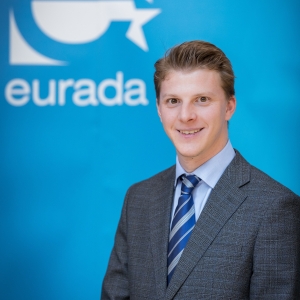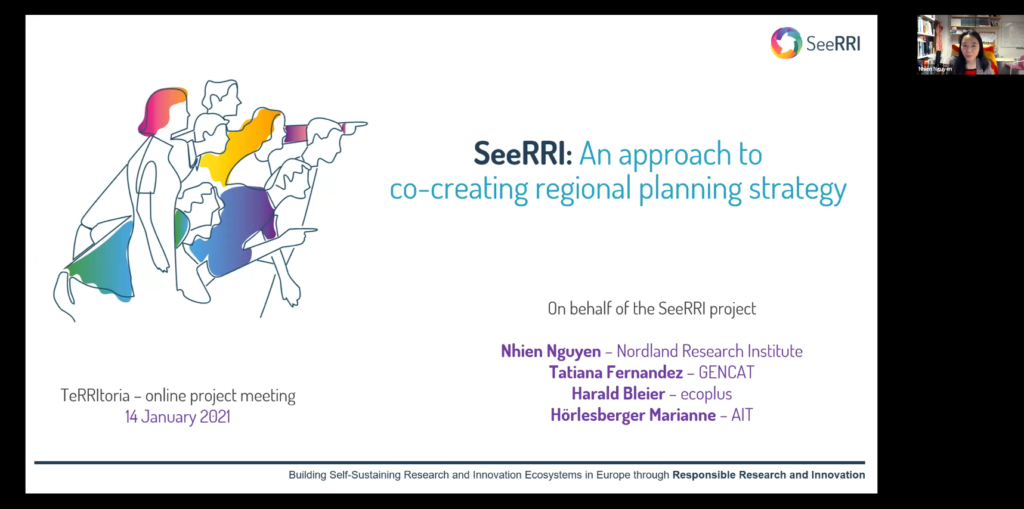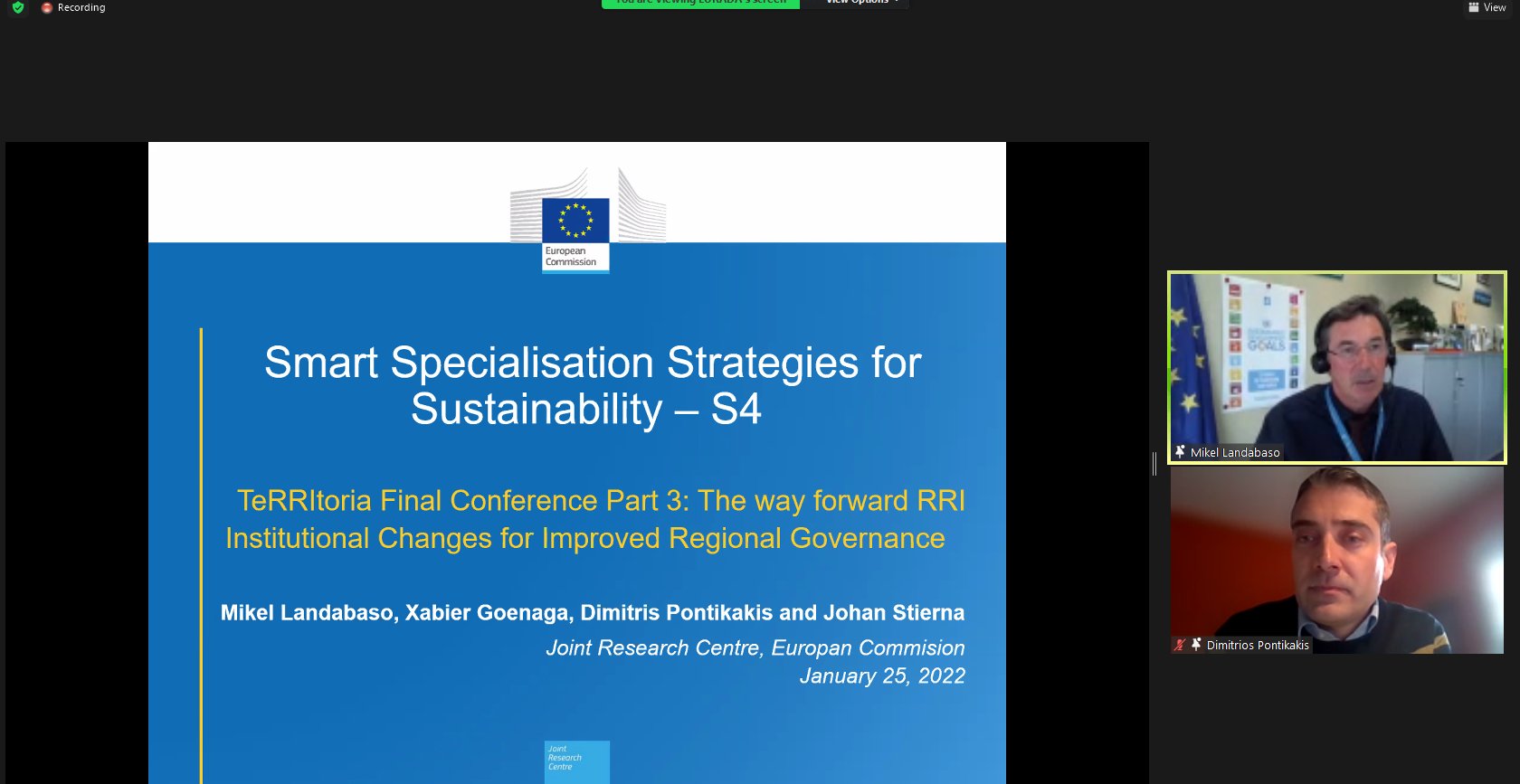Is it possible to implement RRI trough an approach of co-creating regional planning strategy?
A few weeks ago, TeRRItoria invited some representatives of the project SeeRRI for an in-depth discussion about Responsible Research & Innovation (RRI). The main point of the discussion was the question is it possible to adapt the SeeRRI model of RRI implementation at territorial level to other regions/ecosystems?
In order to reply to this question, Nhien Nguyen, SeeRRI Project Coordinator, presented a general overview of the project and then briefly illustrated one of the three experiments foreseen as part of the project: “The Nordland case: an approach to co-creating regional planning strategy”. She presented regional planning as a wicked problem, complex with no clear solution and “no right to be wrong” for the planner as the choices made for the regional planning will have consequences. Nhien pointed out that a mistake commonly made in regional planning is focussing on the best option available for the future, as in actual fact scenario planning is needed in order to develop a strategy that will remain viable in the event of any of the possible scenarios becoming reality. This can only be achieved through a co-creation process including Quadruple Helix stakeholders from the early stages by engaging them and taking account of their different views, knowledges, and interests on an issue that is important for all of them (in the case of Nordland, the issue of the region’s coast and the management thereof). For her, the Nordland-SeeRRI case illustrates the first result of a co-creation process that forms a regional actor network and knowledge platform. The recipe for it would be a compelling mission, the right stakeholders, a creative process and the possibility to leverage all of it. She insisted that it can be transferred to other territories by adapting the territorial focus as was done in Catalonia and Lower Austria.
Tatiana Fernandez, from the Catalan government, presented the second experiment “B – 30 Catalonia: from scenario to strategy”. In Catalonia the starting point was two simple questions “how can Research and Innovation Strategies for Smart Specialisation (RIS3s) promote the R&I ecosystem in the territory? How can universities contribute to more responsible R&I ecosystems?”. Catalonia is characterised by being an industrial region, so the main challenge of the experiment is zero waste. In order to achieve it, a new methodology was developed. The first step was to understand the systemic challenge by mapping the local key stakeholders and initiatives on that topic. Therefore, many workshops and meetings has been organised to identify opportunities, problems, future scenarios and potential pathways. The key element was to discover why so many initiatives were already carried out in the past and none of them was successfully. They developed a transformative agenda for university, government, and civil society in order to move jointly in the same direction with the goal of integrating this new methodology in the S3 strategy.
As a result of this co-creation process, the RIS3 of Catalonia was influenced in several aspects. The local government decided to change the focus from sectors and technologies towards challenges that really mater to the society. In addition, they decided to integrate 4 RRI dimensions by encouraging RRI transformative shared agenda towards mores sustainable and inclusive pathways and SDGs. Entrepreneurial Discovery Process (EDP) also plays a crucial role. Thanks to a combination of top-down and bottom-up approaches, it was possible to reinforce the engagement of Quadruple Helix stakeholders.
During the event, the case of Lower Austria “Co2–neutral economy” was also presented. The main challenge of the Lower Austria case is related to the polymer industry. That sector would like to contribute significantly to a climate-compatible, environmentally friendly, resource-conserving economy through research, development of products by taking into account the entire value chain on the globe via RRI approach.
They were able to overcome the challenge thanks to the fact that stakeholders from the R&I ecosystem placed a strong emphasis on plastic industry. Moreover, one of the partners of the project is Ecoplus, the business Agency of Lower Austria which aims to enhance regional economic competitiveness by encouraging collaboration on innovative intercompany projects. Ecoplus played a crucial role and could be considered as an important success factor.
A well-structured, developed, and designed process and methodology is an essential requirement for the success of the whole transformative experiment. According to the experiences of SeeRRI, developments, changes, and transformation are taking place continuously.
Based on the possible future shapes of the 10 key factors analysed, 4 alternative scenarios for Lower Austria 2040 were developed:
- A world without polymers.
- Everything will be fine. Lower Austria is the Silicon Valley of the plastic industry.
- Happy world – Make great smiles. The climate targets are met.
- No rules, just profit. Maximising the social gap; Dictate of corporations.
In conclusion, SeeRRI representatives agreed on the fact that moving S3s towards the Sustainable Development Goals requires new planning of the co-creation process which must be designed carefully. Nhien, illustrates the first result of a co-creation process that forms a regional actor network and knowledge platform. The recipe for it would be a compelling mission, the right stakeholders, a creative process, and the possibility to leverage all of it. She believes that it can be adapted to other territories, as Catalonia and Lower Austria have also applied the same process in SeeRRI.
She also stressed how, when sharing a project’s methodology with new regions, it is important to make sure that they understand the context and that there is a shared understanding between what is being shared and the context in the region it is being shared with.
When asked whether she thinks co-creation could be useful in the implementation of S3s, Nhien replied that co-creation is an important element in S3 as it is crucial to bringing together key actors in the regions to make a plan for their own future.
 | Article written by Giacomo Frisanco – EURADA. Giacomo joined EURADA in 2019 as Project and Communication officer. He deals with Communication, Dissemination, and Exploitation task for both Interreg Europe and Horizon 2020 projects. |





